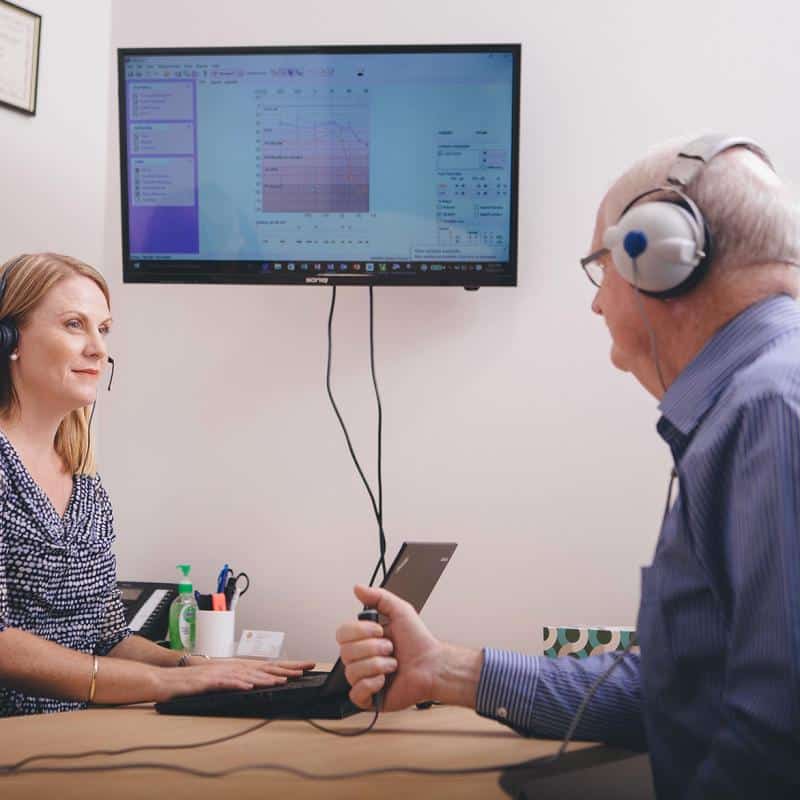The different types of hearing tests and what to expect should you need one
Before we talk about the hearing tests – it is important to understand how we hear. Our ears are made up of three parts the outer, middle and inner ear.
- The Outer Ear
The outer ear includes the pinna, this is the part of your ears you can see on the sides of your head and the canal itself. The pinna helps capture the sound and make sense of where it comes from. The sound then travels down the ear canal and moves towards the eardrum, the start of the middle ear. - The Middle Ear
The eardrum is connected to the 3 smallest bones in our body, called ossicles. The vibrations from the eardrum are passed on to the 3 ossicles attached in a chain-like configuration which constantly vibrates back and forth when sound is detected. This sound is then passed further along to the inner ear. - The Inner Ear
Here we find the hearing organ, known as the cochlea and our balance organs (the semicircular canals and otoliths). The cochlea is a bony coil-like structure, resembling a snail. The cochlea contains fluid and tiny delicate structures known as hair cells. When the bones in our middle ear are displaced, the fluid in the cochlea moves and triggers the movement of the hair cells. The hair cells are connected to a hearing nerve, and with hair cell movement the hearing nerve sends the sound signal to the brain. It is here where the sounds are processed for meaning and interpretation.
Each part of the ear plays a crucial role in how we hear. Problems in sound transmission through any part of the ear can result in a different degree and type of hearing loss. We must, therefore, have tests for each part of the ear administered by a fully qualified audiologist.
Pure tone screening
A machine called an audiometer produces a range of beeps and whistles (pure tones) of the differing pitch. Headphones or insert ear tips are used and require you to respond using a buzzer whenever a sound is heard. This tests your outer, middle ear and inner ear hearing pathways.
Bone conduction testing
A headband like structure, the bone conductor, is placed behind the ear. The test is measured the same as the pure tone test using a buzzer when the sound is heard. This test, however, bypasses the outer and middle ear and tests the inner ear directly. Should the result differ to those gathered through pure tone testing this is used in identifying the type of hearing loss?
Tympanometry testing
Measures the function of the middle ear. A probe like a device that changes the air pressure in the ear is used to detect movement of the eardrum and connected ossicle chain.
Acoustic reflex testing
Using the same probe like device this is another automatic test measuring both middle and inner ear functions. The test involves presenting the ear with loud sounds of the differing pitch to trigger an involuntary muscle contraction of the middle ear. The results of this test in combination with the above tests are used to determine the location of hearing loss or to confirm normal hearing.
Speech discrimination testing
This test assesses outer, middle and inner ear function. You are played a series of words/sentences under headphones in both quiet and noise and asked to repeat what is heard. This test is assessing the clarity of your hearing.
What should you expect from a diagnostic hearing assessment?
You may be referred by your GP, another health professional or self-referred for a diagnostic hearing assessment.
All assessments should be completed in a sound-treated office room in privacy.
- A detailed QA session with your audiologist to determine the difficulties you have been experiencing with your hearing
- Otoscopy– a thorough examination of your ear and eardrum using a special medical device known as an otoscope and/or voroscope
- Pure tone screening
- Bone conduction testing
- Speech discrimination testing
- Tympanometry testing
- Acoustic reflex testing
- Results– a detailed discussion of your hearing results and management moving forward.
- A report to be sent to GP/other health professionals of your choice
This is what you should expect if you are booked in for this kind of appointment which can take up to
Don’t have any noticeable concerns for your hearing but are wanting a quick check/baseline?
Book in for a pure tone screening. Should this result indicate poor hearing the audiologist will discuss how further testing may be suitable for you!


